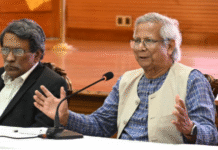A breath of not so fresh air
A data-driven exploration of Dhaka’s air quality

We all know that the air quality in Dhaka is bad. Anyone living in the city only has to clean a surface at home in the morning and see the visible layer of dust magically reappear by the time you return from work, or spend a little time outdoors and just feel the air in your throat to know there is a real problem. But how bad is it truly? And are there insights that the data can reveal to us?
The US consulate in Baridhara has been collecting air quality readings since March 2016 and, in the spirit of open data, publishes an hourly update online (it even has its own Twitter handle @Dhaka_Air). Their air quality monitor measures the average concentration of fine particle pollutants (PM2.5) in the air over an hour and converts this into an Air Quality Index (AQI) value. AQI is a numerical scale, between 0 and 500, informing how potentially dangerous the air is to health, where small numbers are good and large numbers are bad.
The recognised acceptable standard for AQI is up to 100, once the quality of air degrades to an AQI above 100, sensitive groups of people may experience adverse health effects. AQI values above 150 are considered “unhealthy”, meaning everyone begins to be at risk of adverse health issues, the severity of which increases as the AQI gets larger — with air deemed “very unhealthy” at AQI in excess of 200 and “extremely unhealthy” above 300.
Figure 1: Daily (data points) and monthly (solid line) average AQI values over the last four years. Visualisation by author; data source: US embassy, Dhaka.

From analysing and displaying the data from the last four years, two things are immediately obvious from the graph; (1) Dhaka air is rarely below the safe AQI standard of less than 100 and (2) there is clearly seasonal variation, with air quality being much worse during the winter months and at its best during monsoon season.
Over the last four years, only 25 percent of days had an average AQI in the desirable safe range of less than 100, and 45 percent of days had an average AQI in the “unhealthy” range of more than 150. In the dry winter months from November to March, the air quality is especially bad and is commonly in the “very unhealthy” or even “extremely unhealthy” range. In fact, with the exception of Dec 2017 (which was borderline at 195), the monthly average AQI for December, January and February has been “very unhealthy” (i.e AQI>200) consistently for the last four years.
Intuitively, anyone living in the city already knows this. Just recall how pleasant it is to take a deep breath after a monsoon rain and compare it to last weekend (which saw an “extremely unhealthy” average AQI of 307 on the day of Pohela Falgun). But why is this the case?
During winter in Bangladesh, an unfortunate combination of meteorological, geographical and human factors work in tandem to create and keep high levels of pollutants in the air. Firstly, highly polluting industries like brick manufacturing (a Department of Environment study in 2014 attributed 58 percent of Dhaka’s air pollution to brick kilns) and construction work are substantially increased in winter to offset lost productivity during the wet season. This then combines with a meteorological phenomenon called “temperature inversion”, in which colder winter air, which you may recall from physics classes is more dense (since hot air expands), gets trapped under a layer of warmer air in the atmosphere. This blanket of warmer air prevents polluted air at ground level from mixing with clean air at higher altitudes and dispersing pollutants away. So, we have a situation where there is a higher production of pollutants and a weakened mechanism to carry them away.
Relief eventually comes as temperatures rise for summer, since the warmer air mixes with the higher atmosphere and is more effective in dispersing pollutants. Additionally, as the monsoon rains begin in earnest, the rains washout pollutants from the air and many pollutants-creating industries and construction work scale back.
Given that we are breathing in “unhealthy” air during nearly half (45 percent) of the year in Dhaka, what exactly are the health risks? The data analysed here is based on readings of PM2.5, which are measurements of fine particulate matter, arguably the most dangerous commonly measured pollutant. The size of these pollutants (less than 2.5 microns) means they can be suspended in the air for long periods of time and can infiltrate deeply into the lungs, bypassing the body’s natural filtration systems, and even enter the bloodstream, increasing the risk of cardiovascular and respiratory disease, and cancers. A 2016 World Health Organisation (WHO) estimate says that air pollution causes 4.2 million premature deaths worldwide per year.
Is there any way for us to avoid this bad air quality? Well, if you are health conscious and going for an early morning jog or walk thinking “less cars are out so the air must be cleaner”, I have some bad news for you. By exploring how the data changes with respect to time of day, it turns out the air quality is at its worst during the night and early morning. Despite the increased number of cars on the road at this time, the hours with the best air quality are generally 10AM to 6PM (see Figure 2, which shows the average hourly AQI by months of the year). What is going on? Well, remember the temperature inversion, where cooler air doesn’t mix as well with the upper atmosphere? The same thing happens during the night. So counterintuitively, despite more pollutants being produced during the day, there is less pollution because the hotter daytime air rises and mixes with cleaner air at higher altitudes, dispersing these pollutants more effectively.
Figure 2: Average AQI values per hour of the day per month. Visualisation by author; data source: US embassy, Dhaka.

So unfortunately, we have little individual control over the air around us. However, there are certain small measures you can employ to mitigate the adverse effects to your personal health. Avoid vigorous exercise outdoors during the night and morning hours when air quality is worse. If you are fortunate enough to be able to afford one, a good quality face mask can protect you while outside (unfortunately a scarf or a cheap surgical mask does little to filter out these harmful fine PM2.5 pollutants). When indoors, close the windows and use an air purifier, especially during winter nights when the air quality is at its worst.
But of course, like all environmental issues, it is the more vulnerable members of society most at risk – those without the luxury of homes with windows, and access to expensive masks and electrical appliances. This situation is exacerbated by the common practice of cooking on open fires in and around the home in these communities – another significant source of air pollutants. With this in mind, the only thing we can do is to try and exert whatever pressures we can on getting increased regulation for high pollutant emitting industries, such as brick kilns. A Department of Environment (DoE) report suggests that over 2400 brick kilns were operating illegally as of August 2019. Positive initiatives seem to be underway in this area, with DoE Director Ziaul Haque announcing in July 2019 that the government plans to convert all brick kilns from fire to non-fire ones, and in November 2019 the High Court ordered the closure of illegal kilns in order to curb air pollution. However, reports have since emerged that some of the kilns closed in this drive are already resuming operations, so clearly there is a lot more that needs to be done.
In the meantime, the data brings some hope — March is coming and the air should improve over the months ahead — the silver lining to the sweaty Bangladeshi summer.
Dr Timothy S. Green is a British physicist and data enthusiast. He works as Technical Lead, Libraries Unlimited at British Council Bangladesh.









